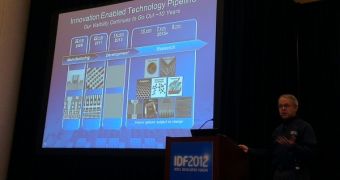Intel is apparently now solely focused on mobile technologies while high performance desktop processors with ever rising high frequencies are not the company’s top priority anymore. The semiconductor giant takes the ARM threat very seriously.
We’ve reported here about AMD’s experiments with denser microchip designs and we’ve explained that you can make a design have a much smaller die and take up considerably less space on the wafer, but the frequency will not grow by much.
We’re used to see that once a semiconductor company moves its designs on a more advanced and smaller manufacturing process, the frequency usually increases while the power consumption goes the other way around.
The thing is that this is not an axiom, but rather a design choice. Of course, the transistors are smaller and consume less energy, but the company specifically places them further apart on the design so that there will not be any hot spots on the chip die.
This makes the die bigger, but also allows the company to safely increase the working frequencies of the chips.
There are automated design tools that will place all the transistors and units as tight as possible while ensuring the chip works flawlessly.
Such a design has a considerably smaller die that’s cheaper to manufacture, but will have significantly lower working frequencies.
AMD is experimenting with these concepts as we detailed here, but Intel has reportedly also decided to go for increased density in the detriment of the high frequencies that would otherwise be attainable.
Therefore, Intel decided to go for 14nm instead of 16nm manufacturing and the process bears the name P1272. This is the same name tag that was initially assigned to the 16nm process.
The company says that its 14nm manufacturing process is still not ready for mass production, but it hopes it will be at the end of 2013 for a 2014 Broadwell launch.
This is rather strange as we know Intel already has functional 14nm Broadwell processors, as we reported here.
Moreover, during this year’s IDF event, Intel talked about its 10nm process, but all it said was the fact that it will be in mass production by 2015.
We have our doubts that Intel will go so quick from 14nm to 10nm in two consecutive years.

 14 DAY TRIAL //
14 DAY TRIAL //